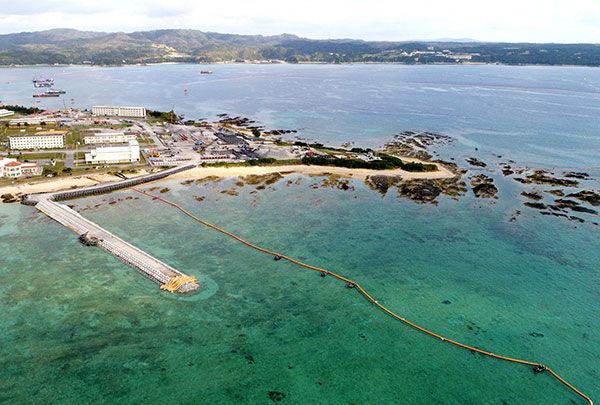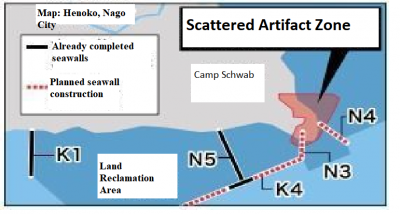Nago City Board of Education to conduct archeological survey in February on Henoko Peninsula, possible affecting base construction

https://ryukyushimpo.jp/news/entry-653410.html
January 26, 2016 Ryukyu Shimpo
By Shohei Tsukazaki
The Nago Board of Education (BoE) and the Okinawa BoE decided January 25 to conduct a cultural asset survey starting in February on the land portion of the “Nagasaki Kaneku Scattered Artifact Zone” located at the tip of the Henoko Peninsula (and surrounding water) inside the U.S. Marine’s Camp Schwab, where new base construction continues.
The scattered artifact zone is adjacent to where the U.S. military is planning to build their N3 and N4 seawalls being built to aid land reclamation.
If the survey were to take a long time to complete, or if archeologically significant findings were made, if has the potential to affect the ongoing construction.
According to the Cultural Assets Preservation Act, no construction can be done within the area encompassing the scattered artifact zone until the survey is complete.
The Nago BoE is currently “in the process of scheduling” the survey.
If the survey were to turn up relics such as village remains, according to the aforementioned preservation law the Okinawan Defense Bureau (ODB) and Nago City, tasked with carrying out the survey, are required to discuss whether or not they are to be preserved, and how to best handle them.

Henoko, Nago City
― Already completed seawalls
—- Planned seawall construction
Scattered Artifact Zone
Camp Schwab
Land Reclamation Area
The survey on the land portion of the artifact-containing area is the first since it was designated an archeological site in July of 2016.
The Nago BoE has also been conducting a similar survey in the water portion of the artifact zone, which overlaps with the area designated for reclamation as part of the base construction, since last April.
With regards to the construction plans in the adjacent area, the ODB went no further than to comment that, “We plan to suitably handle these cultural assets in conjunction with the local BoE, based on the results of the survey and in adherence to all laws and regulations.”
The Okinawa BoE recognized the scattered artifact zone as the 8th site within Camp Schwab in July, 2016. Prior to its designation, a survey conducted by Nago found pottery fragments from the early-modern Ryukyu era (1609-1879) and late-modern era in the area around the artifact zone.
They also discovered a Ryukyu Dynasty-era “anchor stone,” for the first time off of Okinawa’s east coast.
Shoijn Heshiki, head of the Okinawa BoE, said, “Based on the rules set out in the Cultural Assets Protection Act, I want the survey to proceed with objectivity.”
(English translation by T&CT and Sam Grieb)
Previous Article:Music of hope: Uganda children’s choir group gets together with Uruma City children
Next Article:Naha District Court rules Japanese government not liable for war acts committed under the Meiji constitution
[Similar Articles]
- Nago BOE requests cultural property survey to be conducted on Henoko sea area
- Okinawa authorities view earthenware found in Henoko as cultural assets
- Henoko base protestors observe minute of silence for US Marines killed in Osprey crash
- On the 3rd anniversary of the start of Henoko construction, Okinawa residents assemble at the gates of Camp Schwab and on the water to call for a halt to land filling in Henoko
- Okinawa Defense Bureau resumes marine boring survey ignoring OPG’s request to halt it
 Webcam(Kokusai Street)
Webcam(Kokusai Street)


